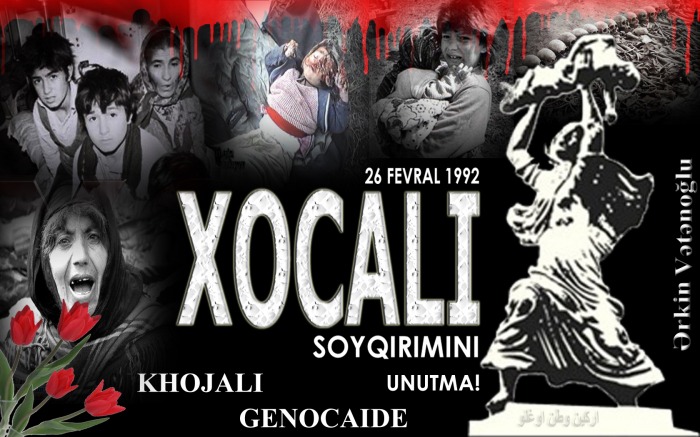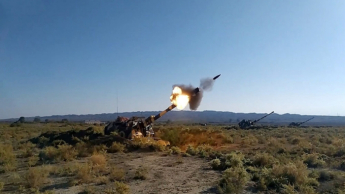Khojaly Genocide from Grief to Victory

|

The Republic of Azerbaijan faced severer ethnic discrimination cleaning and series of genocides in the last two centuries which was indeed full of shambles and shameful deeds of Armenia, a fascist state in South Caucasus region.
Armenian genocides were nothing but serious crime against humanity and peaceful people of Azerbaijan. It was act of state terrorism. It was act of ethnic cleansing. In this connection, the “Khojaly genocide” was purely brutal action of inconceivable cruelty during which inhuman punitive methods waere forcefully used.
Unfortunately, Armenians chauvinists and their supportive forces violated the rights of Azerbaijan’s people, created the obstacles to get the education in native language and exerted a strong pressure upon them. Subsequently, the historical names of Azerbaijan villages were changed.
History of human evolution and civilization has been swinging between the pendulum of evilness and search of genuine equality, unlimited tragedies and tranquilities, barbarism and vivid reflection of best human qualities, genocides and generosities, discriminations and diversities and Armenia has been committing serious crimes against innocent people of Azerbaijan living for centuries in these areas but ultimately were butchered and forced to migrate from their native lands and homes.
In this regard, Khojaly tragedy showcased momentum of evil energies whereas The Center of South Asia & International Studies (CSAIS) Islamabad is the hub of positive energy, channelizing human spirits towards greater resolution, infinite voyage of peace, harmony, dignity and development.
Despite conflicting realities and pinching & painful grieves the government and people of Azerbaijan moved forward from national loss and collateral damages to greater socio-economic development, regional connectivity and above all qualitative life because pure human spirits are always die-hard to conquer and its modern national history proves it.
Ironically, Azerbaijan’s population was repeatedly subjected to the gross human rights violations, ethnic cleansing and deportation accompanied by inhuman and degrading treatment by Armenian nationalists (in 1905-1907, 1918-1920, 1948-1953, 1988-1993). The most horrible one of such tragedies against the Azerbaijan people was the genocide committed 105 years ago, on March 31, 1918. Since March of 1918, thousands of the Azerbaijan civilians have had been killed on the ground of their nationality; people were burned alive; rare historical monuments, schools, hospitals, mosques were intentionally ruined.
During Khojaly genocide Armenians completely targeted the people of Azerbaijan and committed a barbarian act. The Khojaly genocide the tragedy of the 20th century was a result of Armenian aggressive and criminal policy. The Khojaly genocide was one of the most terrible and tragic pages of Azerbaijan history. Merciless and cruel genocide was also the most dreadful mass terror act in the history of humankind. It was one of the most serious crimes not only against the people of Azerbaijan, but humanity as a whole. The Khojaly genocide may be compared to the genocides in Khatin, Hiroshima, Nagasaki and Songmi.
Khojaly reflected the history and traditions of Azerbaijan since the ancient times. Its culture is classified as Khojaly-Gadabay in the Azerbaijani history. Cromlechs, dolmens, Cyclops, tumulus’s of Khojaly, as well as different housing wares were the patterns of material culture that reflectd the dynamics of social development.
The destruction of all these material culture monuments and Khojaly graveyard one of the most ancient cemeteries in history after the Armenian occupation was obvious examples of Armenian barbarism and aggression against the world culture.
Armenian military forces committed genocides in the town of Khojaly with the population of seven thousand people on February 26 1992. There were three thousand people in the town at the time of Armenian military forces' attack. 613 people were killed, 1000 peaceful people of different age became invalid during Khojaly genocide. 106 women, 63 children, 70 old men were killed. Many families were completely annihilated, 130 children lost one parents, while 25 both of them. 1275 peace residents were taken hostages the fate of 150 of them is still unknown.
Moreover, Azerbaijan has had been victim of planned ethnic cleansing and genocide by Armenian for 200 years. The people of Azerbaijan were deported from their historical lands and became refugees and internally displaced persons (IDPs) because of Armenian illegal occupation.
Azerbaijanis were also forced to leave from their historical lands during the former Soviet period. 150,000 Azerbaijanis were deported from Armenia and placed in the Kur-Araz plain from1948-1953. 250,000 Azerbaijanis were forced to migrate from their historical territories in 1988 and Armenia became a mono-ethnical state.
The Daghlig Garabagh events, which started in 1988 along with continuous efforts to implement the Armenian desire of building a state from sea to sea, led to the destruction of towns and villages, murder of thousands of innocent people, as well as the exile of hundreds of thousands of Azerbaijanis from their native lands.
To achieve dreams of great Armenian its nationalists expanded their illegal activities in the early 20th century. It was coined by the Dashnaktsutyun Party which systematically expelled Azerbaijanis from their historical lands and native homes and embarked on a policy of ethnic cleansing and genocide.
For example, in 1905-1906 the Armenians committed massacres against Azerbaijani civilians in Baku, Ganja, Karabakh, Irevan, Nakhchivan, Ordubad, Sharur-Daralayaz, Tiflis, Zangezur, Gazakh and other places, perpetrated ruthless massacres against the local population, burned and destroyed cities and villages. Armenian armed forces destroyed more than 200 Azerbaijani villages in Shusha, Zangezur and Jabrayil region, Irevan and Ganja provinces, expelling tens of thousands of Azerbaijanis from their homes.
Human bloods were everywhere and beasts were in search of innocent Azerbaijan people. Bloody events soon spread out covering the entire territory of Azerbaijan. In March-April 1918, about 8,000 civilians were slaughtered in Shamakhi. Armenian gangs stormed the city, setting houses on fire. Those who were trying to escape from the fire were shot. The majority of Muslim monuments of culture, including the Friday Mosque of Shamakhi, were set on fire and burnt to the ground with elderly, women and children hiding in it. People were buried alive, while some were brutally tortured before being killed.
Moreover, Armenian nationalists killed with utmost cruelty more than 16,000 people in Guba, the “valley of blood” in the first five months of 1918. The facts of mass extermination of the Azerbaijanis of Guba by Armenian-Dashnak gangs were proven again in the 21st century the discovery in 2007 of mass graves in Guba is a fact confirming the Armenian brutality. The study of the burial site revealed that people were subjected to unprecedented violence and killed with cruelty during the Armenian armed attack on Guba in 1918.
A ruthless massacre of the Azerbaijanis was also perpetrated in Shusha, Irevan, Zangezur, Karabakh, Nakhchivan, Kars and other regions. When committing these atrocities on historical Azerbaijani lands, the Armenians burned schools and mosques and destroyed samples of material culture of Azerbaijanis.
During genocides humanity was “bleeded” and “beasts” were everywhere in different cities of Azerbaijan but it could not strike-down the true spirits of interfaith harmony, patriotism, national pride and communal unity and people having diversity of faiths, beliefs and origins stood fast to fight against all odds.
Cities were sieged and darkness was everywhere. Men were arrested. Media was blocked and the people were deprived of the right to access information. There was complete chaos. Azerbaijanis were determined to protect their territorial integrity and did not step back, showing their sacrifice and vigor for the national freedom.
Genocides against Azerbaijan people also uphold “grief” which has enduring human befitting propositions. It united the people of Azerbaijan despite ethnic diversity and strengthened their resolve to achieve that independence.
Ultimately, the sustained values of faith, courage, and the strength of human spirits which are universal and everlasting re-conquered the illegally occupied territories of Karabakh. It was act of perseverance and will to move on and move forward with a better life, a life of freedom, fairness, tolerance and peace and it had also left an even stronger and even greater impression in daily lives of people to centralization of command to national politics to the regional geopolitics.
To conclude, genocides against Azerbaijan achieved nothing but widespread condemnation. Rather it fueled concepts of self-defense, self-reliance, economic sustainability, protection of national pride, safety of heritage and unbending passions for territorial sovereignty in Azerbaijan in which the role of its visionary leadership is commendable.
Khojaly grief shadows has been converted into shining Azerbaijan due to which it has now achieved and secured a miraculous victory and de-occupied Nagorno karabakh and others areas from Armenia after 30 years.
The author: Executive Director of the Center for South Asia & International Studies (CSAIS), regional expert on Azerbaijan & South Caucasus
(If you want to contribute and have specific expertise, please contact us at [email protected])
The Rocket and Artillery formations of the Azerbaijan Army conduct live-fire exercises in accordance with the combat training plan for 2021, the Ministry of Defense of Azerbaijan told Baku Tribune.
LAST NEWS





.jpg&h=67&w=67&zc=1&q=100)













